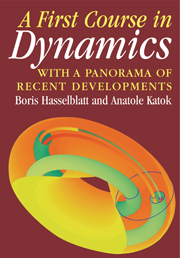Book contents
- Frontmatter
- Contents
- Preface
- 1 Introduction
- PART 1 A COURSE IN DYNAMICS: FROM SIMPLE TO COMPLICATED BEHAVIOR
- PART 2 PANORAMA OF DYNAMICAL SYSTEMS
- 9 Simple Dynamics as a Tool
- 10 Hyperbolic Dynamics
- 11 Quadratic Maps
- 12 Homoclinic Tangles
- 13 Strange Attractors
- 14 Variational Methods, Twist Maps, and Closed Geodesics
- 15 Dynamics, Number Theory, and Diophantine Approximation
- Reading
- APPENDIX
- Hints and Answers
- Solutions
- Index
14 - Variational Methods, Twist Maps, and Closed Geodesics
Published online by Cambridge University Press: 05 June 2012
- Frontmatter
- Contents
- Preface
- 1 Introduction
- PART 1 A COURSE IN DYNAMICS: FROM SIMPLE TO COMPLICATED BEHAVIOR
- PART 2 PANORAMA OF DYNAMICAL SYSTEMS
- 9 Simple Dynamics as a Tool
- 10 Hyperbolic Dynamics
- 11 Quadratic Maps
- 12 Homoclinic Tangles
- 13 Strange Attractors
- 14 Variational Methods, Twist Maps, and Closed Geodesics
- 15 Dynamics, Number Theory, and Diophantine Approximation
- Reading
- APPENDIX
- Hints and Answers
- Solutions
- Index
Summary
In this chapter we leave the area of hyperbolic dynamics, which dominated the Panorama so far, and we describe some applications of the variational approach to dynamics that are among the most impressive and at the same time easily visualizable. The variational approach was first mentioned in Chapter 6 in connection with the Lagrangian formalism and then in the specific context of billiards. We begin with the study of twist maps, which include billiards in convex domains as a special case and provide an ideal setting for the variational approach due to the relatively simple structure of the phase space. Aubry–Mather theory establishes the existence of a full range of motions with the features of orbits of one-dimensional maps whose rotation numbers are compatible with the amount of twist in the system. These motions can be viewed as “traces” or “ghosts” of invariant curves. Thus we obtain both the remnants of “order,” and the presence of chaos, since in the absence of genuine invariant curves the interaction between periodic orbits and Cantor-like sets produces not only homoclinic and heteroclinic tangles but also complex behavior of an even more baffling kind and puts a rigorous description of typical behavior way beyond the reach of current methods.
We continue with results that involve fewer assumptions on dynamics and deeper use of topology and end up with the description of one of the most impressive applications of dynamics to geometry: the existence of infinitely many closed geodesics for every Riemannian metric on the two-dimensional sphere.
- Type
- Chapter
- Information
- A First Course in Dynamicswith a Panorama of Recent Developments, pp. 342 - 364Publisher: Cambridge University PressPrint publication year: 2003



